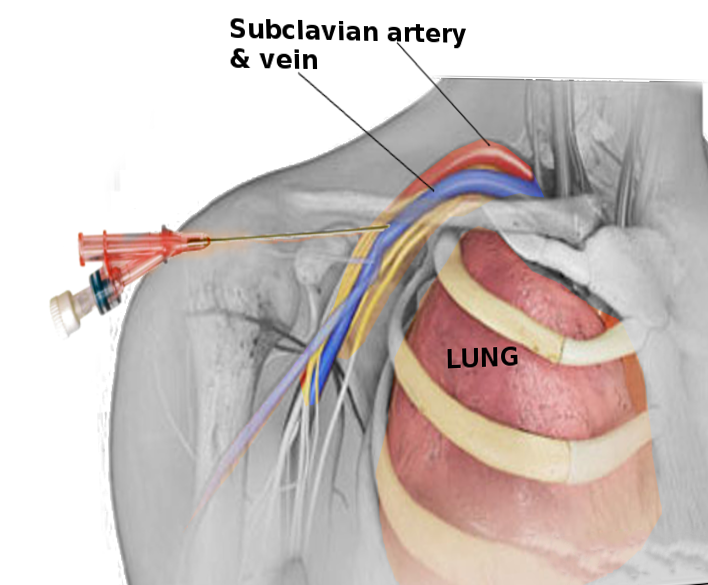[1]
Butt MU,Gurley JC,Bailey AL,Elayi CS, Pericardial Tamponade Caused by Perforation of Marshall Vein During Left Jugular Central Venous Catheterization. The American journal of case reports. 2018 Aug 9
[PubMed PMID: 30089768]
Level 3 (low-level) evidence
[2]
Criss CN,Claflin J,Ralls MW,Gadepalli SK,Jarboe MD, Obtaining central access in challenging pediatric patients. Pediatric surgery international. 2018 May
[PubMed PMID: 29582149]
[3]
Struck MF,Ewens S,Schummer W,Busch T,Bernhard M,Fakler JKM,Stumpp P,Stehr SN,Josten C,Wrigge H, Central venous catheterization for acute trauma resuscitation: Tip position analysis using routine emergency computed tomography. The journal of vascular access. 2018 Sep
[PubMed PMID: 29529967]
[4]
Paik P,Arukala SK,Sule AA, Right Site, Wrong Route - Cannulating the Left Internal Jugular Vein. Cureus. 2018 Jan 9
[PubMed PMID: 29541565]
[5]
Merchaoui Z,Lausten-Thomsen U,Pierre F,Ben Laiba M,Le Saché N,Tissieres P, Supraclavicular Approach to Ultrasound-Guided Brachiocephalic Vein Cannulation in Children and Neonates. Frontiers in pediatrics. 2017
[PubMed PMID: 29051889]
[6]
Wang H,Chen Y,Liu A,Xiang J,Lin Y,Wen Y,Wu X,Peng J, [Complications analysis of subcutaneous venous access port for chemotherapy in patients with gastrointestinal malignancy]. Zhonghua wei chang wai ke za zhi = Chinese journal of gastrointestinal surgery. 2017 Dec 25
[PubMed PMID: 29280123]
[7]
Shibata W,Sohara M,Wu R,Kobayashi K,Yagi S,Yaguchi K,Iizuka Y,Iwasa M,Nakahata H,Yamaguchi T,Matsumoto H,Okada M,Taniguchi K,Hayashi A,Inazawa S,Inagaki N,Sasaki T,Koh R,Kinoshita H,Nishio M,Ogashiwa T,Ookawara A,Miyajima E,Oba M,Ohge H,Maeda S,Kimura H,Kunisaki R, Incidence and Outcomes of Central Venous Catheter-related Blood Stream Infection in Patients with Inflammatory Bowel Disease in Routine Clinical Practice Setting. Inflammatory bowel diseases. 2017 Nov
[PubMed PMID: 29045261]
[8]
Akaraborworn O, A review in emergency central venous catheterization. Chinese journal of traumatology = Zhonghua chuang shang za zhi. 2017 Jun
[PubMed PMID: 28552330]
[9]
Kornbau C,Lee KC,Hughes GD,Firstenberg MS, Central line complications. International journal of critical illness and injury science. 2015 Jul-Sep;
[PubMed PMID: 26557487]
[10]
Bhutta ST,Culp WC, Evaluation and management of central venous access complications. Techniques in vascular and interventional radiology. 2011 Dec;
[PubMed PMID: 22099014]
[11]
McGee DC,Gould MK, Preventing complications of central venous catheterization. The New England journal of medicine. 2003 Mar 20
[PubMed PMID: 12646670]
[12]
Bowdle A, Vascular complications of central venous catheter placement: evidence-based methods for prevention and treatment. Journal of cardiothoracic and vascular anesthesia. 2014 Apr;
[PubMed PMID: 24008166]
[13]
Vats HS, Complications of catheters: tunneled and nontunneled. Advances in chronic kidney disease. 2012 May;
[PubMed PMID: 22578679]
Level 3 (low-level) evidence
[14]
Patel AR,Patel AR,Singh S,Singh S,Khawaja I, Central Line Catheters and Associated Complications: A Review. Cureus. 2019 May 22;
[PubMed PMID: 31355077]
[15]
Schelling G,Briegel J,Eichinger K,Raum W,Forst H, Pulmonary artery catheter placement and temporary cardiac pacing in a patient with a persistent left superior vena cava. Intensive care medicine. 1991;
[PubMed PMID: 1797901]
[16]
Andrews RT,Geschwind JF,Savader SJ,Venbrux AC, Entrapment of J-tip guidewires by Venatech and stainless-steel Greenfield vena cava filters during central venous catheter placement: percutaneous management in four patients. Cardiovascular and interventional radiology. 1998 Sep-Oct;
[PubMed PMID: 9853151]
[17]
Wang HE,Sweeney TA, Subclavian central venous catheterization complicated by guidewire looping and entrapment. The Journal of emergency medicine. 1999 Jul-Aug;
[PubMed PMID: 10431965]
[18]
Song Y,Messerlian AK,Matevosian R, A potentially hazardous complication during central venous catheterization: lost guidewire retained in the patient. Journal of clinical anesthesia. 2012 May;
[PubMed PMID: 22495087]
[19]
Jalwal GK,Rajagopalan V,Bindra A,Rath GP,Goyal K,Kumar A,Gamanagatti S, Percutaneous retrieval of malpositioned, kinked and unraveled guide wire under fluoroscopic guidance during central venous cannulation. Journal of anaesthesiology, clinical pharmacology. 2014 Apr;
[PubMed PMID: 24803771]
[20]
Konichezky S,Saguib S,Soroker D, Tracheal puncture. A complication of percutaneous internal jugular vein cannulation. Anaesthesia. 1983 Jun;
[PubMed PMID: 6869717]
[21]
Early TF,Gregory RT,Wheeler JR,Snyder SO Jr,Gayle RG, Increased infection rate in double-lumen versus single-lumen Hickman catheters in cancer patients. Southern medical journal. 1990 Jan;
[PubMed PMID: 2300831]
[22]
Khouzam RN,Soufi MK,Weatherly M, Heparin infusion through a central line misplaced in the carotid artery leading to hemorrhagic stroke. The Journal of emergency medicine. 2013 Sep;
[PubMed PMID: 23849360]
[23]
Kusminsky RE, Complications of central venous catheterization. Journal of the American College of Surgeons. 2007 Apr;
[PubMed PMID: 17382229]
[24]
Matsushima H,Adachi T,Iwata T,Hamada T,Moriuchi H,Yamashita M,Kitajima T,Okubo H,Eguchi S, Analysis of the Outcomes in Central Venous Access Port Implantation Performed by Residents via the Internal Jugular Vein and Subclavian Vein. Journal of surgical education. 2017 May - Jun
[PubMed PMID: 27932306]
[25]
Acar Y,Tezel O,Salman N,Cevik E,Algaba-Montes M,Oviedo-García A,Patricio-Bordomás M,Mahmoud MZ,Sulieman A,Ali A,Mustafa A,Abdelrahman I,Bahar M,Ali O,Lester Kirchner H,Prosen G,Anzic A,Leeson P,Bahreini M,Rasooli F,Hosseinnejad H,Blecher G,Meek R,Egerton-Warburton D,Ćuti EĆ,Belina S,Vančina T,Kovačević I,Rustemović N,Chang I,Lee JH,Kwak YH,Kim do K,Cheng CY,Pan HY,Kung CT,Ćurčić E,Pritišanac E,Planinc I,Medić MG,Radonić R,Fasina A,Dean AJ,Panebianco NL,Henwood PS,Fochi O,Favarato M,Bonanomi E,Tomić I,Ha Y,Toh H,Harmon E,Chan W,Baston C,Morrison G,Shofer F,Hua A,Kim S,Tsung J,Gunaydin I,Kekec Z,Ay MO,Kim J,Kim J,Choi G,Shim D,Lee JH,Ambrozic J,Prokselj K,Lucovnik M,Simenc GB,Mačiulienė A,Maleckas A,Kriščiukaitis A,Mačiulis V,Macas A,Mohite S,Narancsik Z,Možina H,Nikolić S,Hansel J,Petrovčič R,Mršić U,Orlob S,Lerchbaumer M,Schönegger N,Kaufmann R,Pan CI,Wu CH,Pasquale S,Doniger SJ,Yellin S,Chiricolo G,Potisek M,Drnovšek B,Leskovar B,Robinson K,Kraft C,Moser B,Davis S,Layman S,Sayeed Y,Minardi J,Pasic IS,Dzananovic A,Pasic A,Zubovic SV,Hauptman AG,Brajkovic AV,Babel J,Peklic M,Radonic V,Bielen L,Ming PW,Yezid NH,Mohammed FL,Huda ZA,Ismail WN,Isa WY,Fauzi H,Seeva P,Mazlan MZ, 12th WINFOCUS world congress on ultrasound in emergency and critical care. Critical ultrasound journal. 2016 Sep
[PubMed PMID: 27604617]
[26]
Hamilton H, Central venous catheters: choosing the most appropriate access route. British journal of nursing (Mark Allen Publishing). 2004 Jul 22-Aug 11
[PubMed PMID: 15284651]
[27]
Alexandrou E,Spencer TR,Frost SA,Mifflin N,Davidson PM,Hillman KM, Central venous catheter placement by advanced practice nurses demonstrates low procedural complication and infection rates--a report from 13 years of service*. Critical care medicine. 2014 Mar
[PubMed PMID: 24145843]

